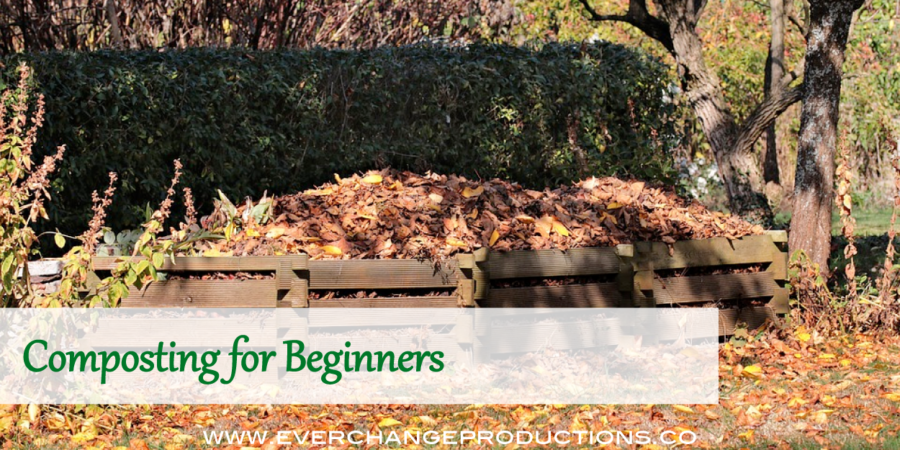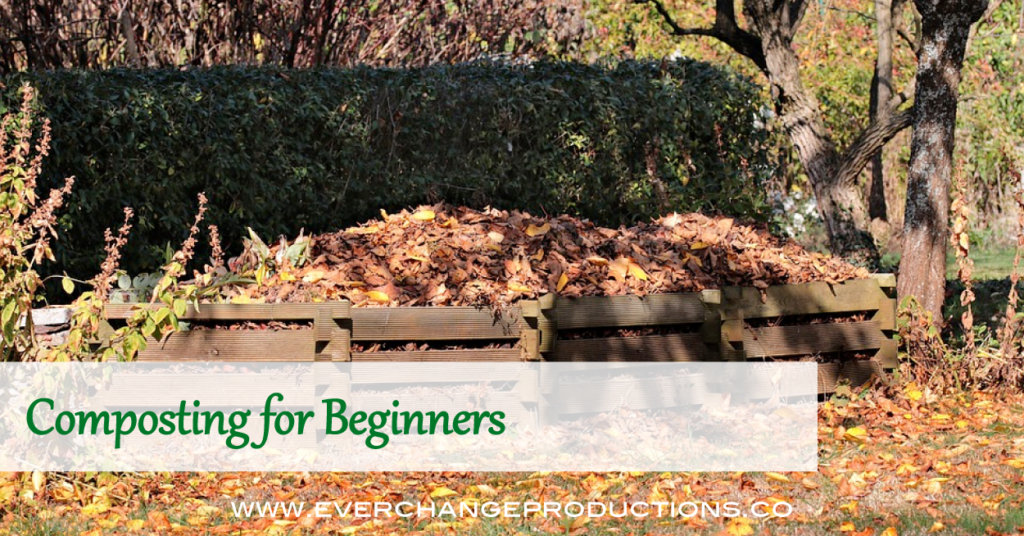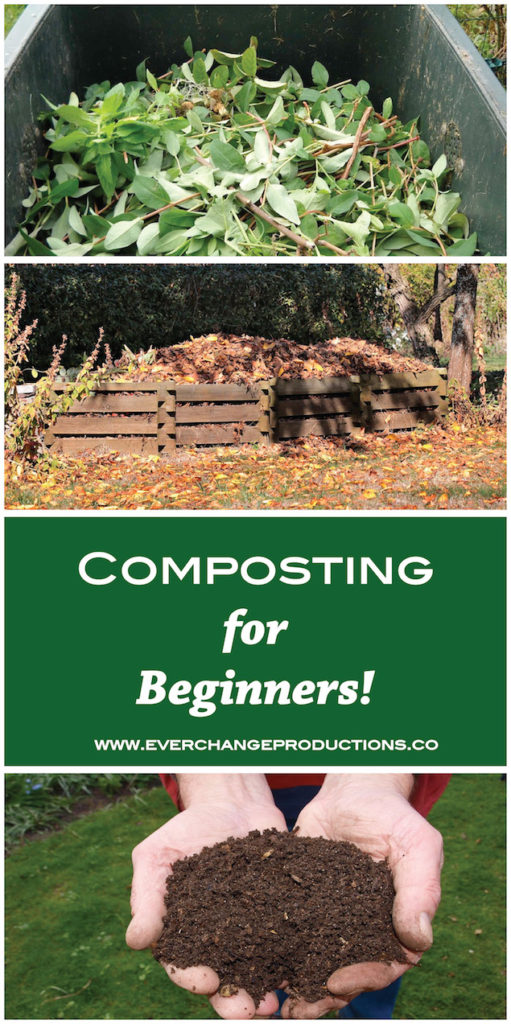Composting Basics
Composting might seem like a daunting task, but this post is everything you need to know about the basics of composting for beginners.
In case you’re on the fence, composting is one of those things that I’ve decided should be the cornerstone practice of anyone trying to be eco-friendly. The thing is that sustainability is about breaking even, but a true eco-friendly lifestyle should be about replenishing the Earth. No other eco-friendly practice does that, except composting. Because the microbes and bacteria in soil take in carbon, replenishing the soil and making it healthy, compost is a great way to offset the carbon emissions.
Growing food, no matter how sustainable, takes nutrients and biomass out of the soil. Yes, technically you can add nutrients with fertilizer, but it’s like feeding the soil cookies. It might give a temporary gain, but in the long run it’s not going to be healthy. Fertilizer lacks all the necessary components for healthy soil. Composting actually helps replenish what was taken out. Without healthy soil we will never have a healthy planet. As I’ve learned more and more about soil, I’ve come to the conclusion that composting is one of the best things we can do for the environment.
If you’re here for the first time, welcome. I’m super excited you’re here trying to leave a smaller footprint and trying new things to make the world a little greener.
The good news is with a few basics of composting for beginners, composting is super easy. The best news is that no matter how big or non-existent your yard is, composting is still possible and you can do it.
Compost Definition
First let’s start with the definition of compost and what we accomplish when we help nature initiate this process.
Compost is decayed organic material used as a plant fertilizer.
It’s the decomposition of plant remains and other once-living materials to make an earthy, dark, crumbly substance that enriching garden soil. It is the way to recycle your yard and kitchen wastes, and is a critical step in reducing the volume of garbage needlessly sent to landfills for disposal.
Composting is not a modern invention. In the natural world, composting is what happens as leaves pile up on the forest floor and begin to decay. Eventually, the rotting leaves are returned to the soil, where living roots can finish the recycling process by reclaiming the nutrients from the decomposed leaves.
In almost every case I say to let nature be- let it do what nature does best. When we skip nature’s process and throw away all our food scraps and yard waste, we are not replenishing nature. We simply take without giving back.
The beauty of composting is ANYONE can do it. Unlike other recycling opportunities, there is no infrastructure required, so any city, any organization, any individual has the ability and the space to compost.
Composting Process
Picking your bin is the first step to composting for beginners. For your average compost bin a yard, you need at least three square feet of space for your compost bin.
If you don’t have a yard, check out this post for composting without a yard. You’ll find a great variety of options!
If you have no idea which composting system is best for you, subscribe for access to a free quiz and find the best composting option for you.
Compost Bins
If you have a yard, you have a couple of options. One, you can build your own bin. You need some wood and basic carpentry skills. You can do a two or three bin system which allows you to have one pile finishing the process, while you start a few compost pile.
Or Two, you can use a closed bin or tumbler. Although, a proper composting pile doesn’t smell, there is always that stigma. A closed bin is a great option to help with composting for beginners. It’s easy to rotate and can make compost in a month or two with proper conditions. It allows you the privacy in case you fear your neighbors will make a stink about you having a bin. Learn more about the compost tumblers and decide if they’re the best choice for you.
Put your bin in a sunny, well-drained area.
Trench Compost
There are a couple of other composting options such as trench composting. This may be the ideal home composting system for people that have garden space who don’t want to fuss with bins and piles. Simply bury your kitchen wastes in a trench 8″ deep dug in the garden, leave the buried materials to rot for a few months, and then plant above them.
Components of a Successful Compost Bin:
The second to composting for beginners it to provide the proper environmental conditions for microbial life. Billions of microbes (fungi, bacteria, etc.) digest the food you provide for them, which makes the compost. If the pile is cool enough, worms, insects, and their relatives will help out the microbes. However, like people, these living things need air, water, and food. If you maintain your pile to provide for their needs, they’ll happily turn your yard and kitchen wastes into compost.
Keep in mind the following basic ideas while building your compost piles:
AIR
Composting microbes are aerobic — they can’t do their work well unless they are provided with air. Without air, anaerobic (non-air needing) microbes take over the pile. They do cause slow decomposition, but tend to smell like putrefying garbage. This is why three square feet is needed for the optimal compost bin. It allows air to make it through the compost pile on all the sides. Turning, completely breaking apart the mixture with a spade or another gardening utensil and then putting it back together, is also a good way to add air to your pile.
WATER
Ideally, your pile should be as moist as a wrung-out sponge to fit the needs of compost microbes. At this moisture level, there is a thin film of water coating every particle in the pile, making it very easy for microbes to live and disperse themselves throughout the pile. If your pile is drier than this, it won’t be very good microbial habitat, and composting will be slowed significantly. If your pile is a great deal wetter, the sodden ingredients will be so heavy that they will tend to mat down and exclude air from the pile, again slowing the composting process (and perhaps creating anaerobic odor problems). Moisten dry materials as you add them to the pile. Watch out for far-too-soggy piles in wet climates (a tarp may help to keep rain off during wet weather).
FOOD
This is probably one of the most important components of composting for beginners.
There are hundreds of options of composting materials. They are broken up into two major categories.
‘Browns’ also known as carbons are dry and dead plant materials such as straw, dry brown weeds, autumn leaves, and wood chips or sawdust. These items are a source of energy for the compost microbes, which is where the ‘greens’ come in. Because they tend to be dry, browns often need to be moistened before they are put into a compost system.
‘Greens’ (nitrogens) are fresh (and often green) plant materials such as green weeds from the garden, kitchen fruit and vegetable scraps, green leaves, coffee grounds and tea bags, fresh horse manure, etc. Compared to browns, greens have more nitrogen in them. Nitrogen is a critical element in amino acids and proteins, and can be thought of as a protein source for the billions of multiplying microbes.
Mixing the Compost
A good mix of browns and greens is the best nutritional balance for the microbes. This mix also helps out with the aeration and amount of water in the pile. Browns, for instance, tend to be bulky and promote good aeration. Greens, on the other hand, are typically high in moisture, and balance out the dry nature of the browns. To keep the proper ratio and prohibit anaerobic decomposition, add twice as much browns as green. Too much browns will only lead to a slower composting process, where as too many greens will lead to a stinky compost pile or attract unwanted critters.
How Long Does Composting Take?
With regular turning, maintaining green and brown ratios and moisture levels, waste can compost in as little as 1 to 2 months. An unmanaged pile could take from six months to two years to compost thoroughly.
Finished compost is entirely broken down and similar to rich, organic soil. You can apply it to your soil or use it in potting mixes.
As you can see, composting for beginners doesn’t have to be overwhelming. With a few composting basics, your compost will be a success. Comment with all your composting questions!


